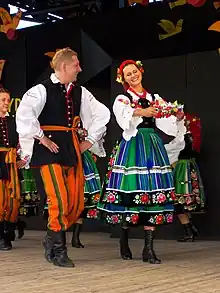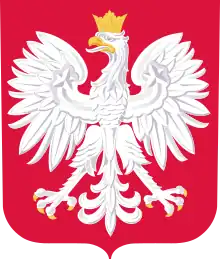National costumes of Poland (Polish: stroje ludowe) vary by region. They are typically not worn in daily life but at folk festivals, folk weddings, religious holidays, harvest festivals and other special occasions.[1] The costumes may reflect region and sometimes social or marital status.[1]
Poland's inhabitants live in the following historic regions of the country: Greater Poland, Lesser Poland, Mazovia, Pomerania, Warmia, Masuria, Podlachia, Kuyavia and Silesia.
Lesser Poland / Małopolska
- Kraków region:[2] The woman's costume includes a white blouse, a vest that is embroidered and beaded on front and back, a floral full skirt, an apron, a red coral bead necklace, and lace-up boots. Unmarried women and girls may wear a flower wreath with ribbons while married women wear a white kerchief on their head. The men wear a blue waistcoat with embroidery and tassels, striped trousers, a krakuska cap ornamented with ribbons and peacock feathers and metal rings attached to the belt.
- Lachy Sądeckie live in southern Lesser Poland, especially in Nowy Sącz County and Kotlina Sądecka.
 Western Kraków region
Western Kraków region Eastern Kraków region
Eastern Kraków region Kraków region
Kraków region Lachy Sądeckie men's costume
Lachy Sądeckie men's costume Lachy Sądeckie, including married woman's costume
Lachy Sądeckie, including married woman's costume Lachy Sądeckie, including unmarried woman's costume
Lachy Sądeckie, including unmarried woman's costume Lesser Poland
Lesser Poland
Gorals / Górale
Gorals live in southern Poland along the Carpathian Mountains, in Podhale of the Tatra Mountains and parts of the Beskids. Their costumes vary depending on the region.[3]


 Żywiec
Żywiec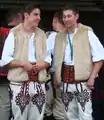 Podhale
Podhale Zakopane (1938)
Zakopane (1938) Szczawnica (1939)
Szczawnica (1939) Gorals from Cieszyn Silesia
Gorals from Cieszyn Silesia Tatra Gorals in 1877
Tatra Gorals in 1877 Żywiec Gorals in 2016
Żywiec Gorals in 2016 Żywiec Gorals in traditional costume
Żywiec Gorals in traditional costume Podhale Gorals in traditional costume
Podhale Gorals in traditional costume
Subcarpathian region / Podkarpacie
 Pogórzanie
Pogórzanie Pogórzanie
Pogórzanie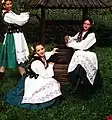 Rzeszowiacy
Rzeszowiacy Pogórzanie
Pogórzanie Sanok (Kamraty)
Sanok (Kamraty)%252C_2010_Bukowsko.JPG.webp) Lasowiacy (Mazurians)
Lasowiacy (Mazurians) Rymanów (Pogórzanie)
Rymanów (Pogórzanie) Liszna (Sanok)
Liszna (Sanok)_..jpg.webp)
 Lemkos from Przemyśl
Lemkos from Przemyśl
Lublin region
 Lublin region
Lublin region Lublin
Lublin
 Biłgoraj
Biłgoraj
Silesia / Śląsk
- Bytom / Piekary Śląskie in Upper Silesia[7]
- Cieszyn Silesia, see
- Lower Silesia



 Lower Silesia
Lower Silesia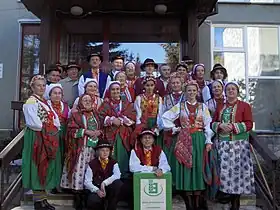 Wilamowice, Vilamovians
Wilamowice, Vilamovians
Pomerania / Pomorze, Kujawy, Warmia

 Kashubia
Kashubia
Masovia and central Poland
Places in Masovia with distinctive costumes include:
- Łowicz[12][13][14]
- Kurpie of the Green and White Primeval Forests[1][15][16]
- Wilanow
- Opoczno[17]
- Sieradz[18]

 Kurpie
Kurpie
 Central
Central Green Forest Kurpie
Green Forest Kurpie Green Forest Kurpie in 1913
Green Forest Kurpie in 1913
Podlaskie / Podlasie
 Podlasie
Podlasie
Greater Poland / Wielkopolska
Upper class
The szlachta were Polish nobles and had their own attire which included the kontusz, pas kontuszowy (sash) and a crimson żupan.[20]
 Nobility
Nobility Bractwo Kurkowe (Kraków)
Bractwo Kurkowe (Kraków).jpg.webp) Bractwo Kurkowe (Kraków)
Bractwo Kurkowe (Kraków) 17th century
17th century
 Żywiec
Żywiec King Stanisław I in a Cracovian costume
King Stanisław I in a Cracovian costume
Burghers
Mieszczanie were Polish burghers, among whom in 18th century czamaras gained a lot of popularity (especially in the Kraków region, hence the alternative name Kraków coat for czamara). In 19th century czamara became a Polish national and patriotic attire.[21]
 Men in czamaras
Men in czamaras Man wearing a czamara
Man wearing a czamara
See also
References
- 1 2 3 "Polish Folk Costumes". The State Ethnographical Museum in Warsaw). Archived from the original on 2013-03-06. Retrieved 2012-05-20.
- ↑ "opis stroju krakowskiego" [Description of Kraków folk costume] (in Polish). polalech.
- ↑ Sieczka, Katarzyna. "Podhalański strój ludowy i jego wytwórcy u progu XXI w." [Podhale folk costume] (in Polish). z-ne.pl.
- ↑ "STRÓJ RZESZOWSKI" [Rzeszów folk costume] (in Polish). Folklor Powiatu Debickiego.
- ↑ "opis stroju lubelskiego" [Description of Lublin folk costume] (in Polish). polalech.
- ↑ "Strój Biłgorajski" [Biłgoraj folk costume] (in Polish). Polska Tradycja.
- ↑ "opis stroju bytomskiego" [Description of Bytom folk costume] (in Polish). polalech.
- ↑ "Ubiór Kaszubski" [Kashubian attire] (in Polish). Kaszuby.vsp.pl.
- ↑ "opis stroju kujawskiego" [Description of Kujawy folk costume] (in Polish). polalech.
- ↑ "Strój Pyrzycki" [Pyrzyce folk costume] (in Polish). Pyrzyce Municipality. 2012-03-20.
- ↑ "Strój Warmiński" [Warmia folk costume] (in Polish). Polska Tradycja.
- ↑ "Strój łowicki" [Łowicz folk costume] (in Polish). Łowicz municipality. Archived from the original on 2013-03-18.
- ↑ "Męski strój łowicki" [Łowicz men's folk costume] (in Polish). Łowicz municipality. Archived from the original on 2013-02-13.
- ↑ "Kobiecy strój łowicki" [Łowicz women's folk costume] (in Polish). Łowicz municipality. Archived from the original on 2009-02-05.
- ↑ "Strój Kurpiowski Puszczy Zielonej" [Green Forest Kurpie folk costume] (in Polish). Polska Tradycja.
- ↑ "Strój Kurpiowski Puszczy Białej" [White Forest Kurpie folk costume] (in Polish). Polska Tradycja.
- ↑ "Strój Opoczyński" [Opoczno folk costume] (in Polish). Polska Tradycja.
- ↑ "Strój Sieradzki" [Sieradz folk costume] (in Polish). Polska Tradycja.
- 1 2 3 "Stroje regionalne" [Regional costumes] (in Polish). Greater Poland region.
- ↑ "opis stroju szlacheckiego" [Description of the costumes of the nobility] (in Polish). polalech.
- ↑ Kubalska-Sulkiewicz, Krystyna; Bielska-Łach, Monika; Manteuffel-Szarota, Anna (1996). Słownik terminologiczny sztuk pięknych. Warszawa: Wydawnictwo Naukowe PWN. ISBN 83-01-11785-0.
External links
 Media related to Traditional clothing of Poland at Wikimedia Commons
Media related to Traditional clothing of Poland at Wikimedia Commons


